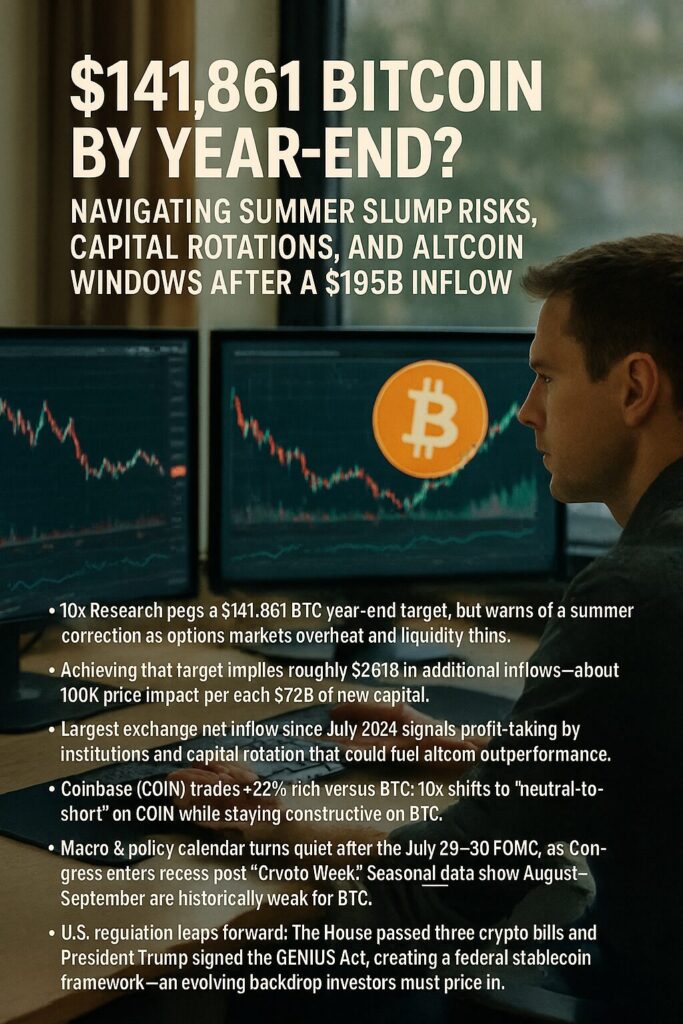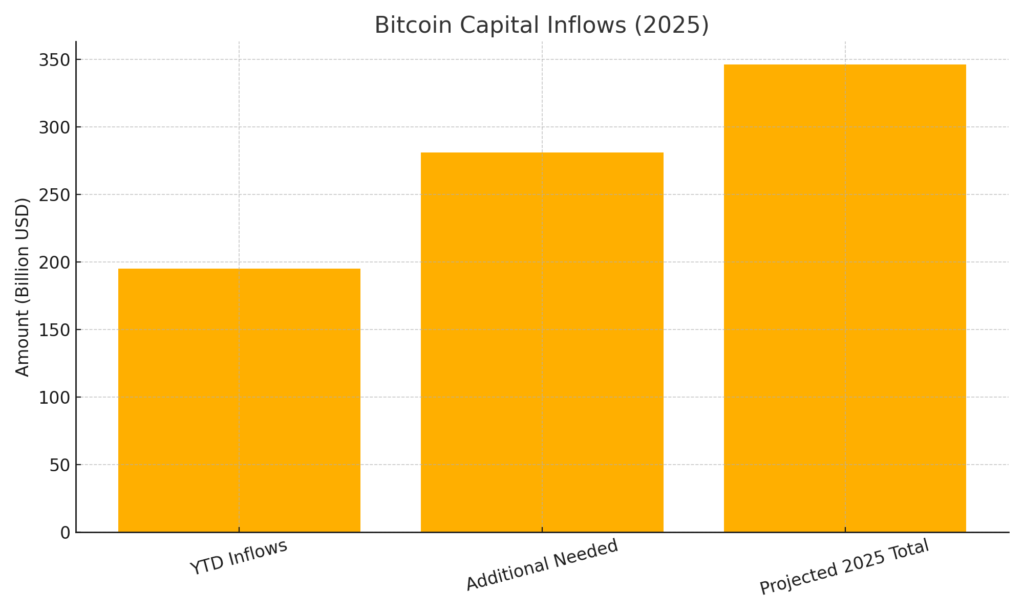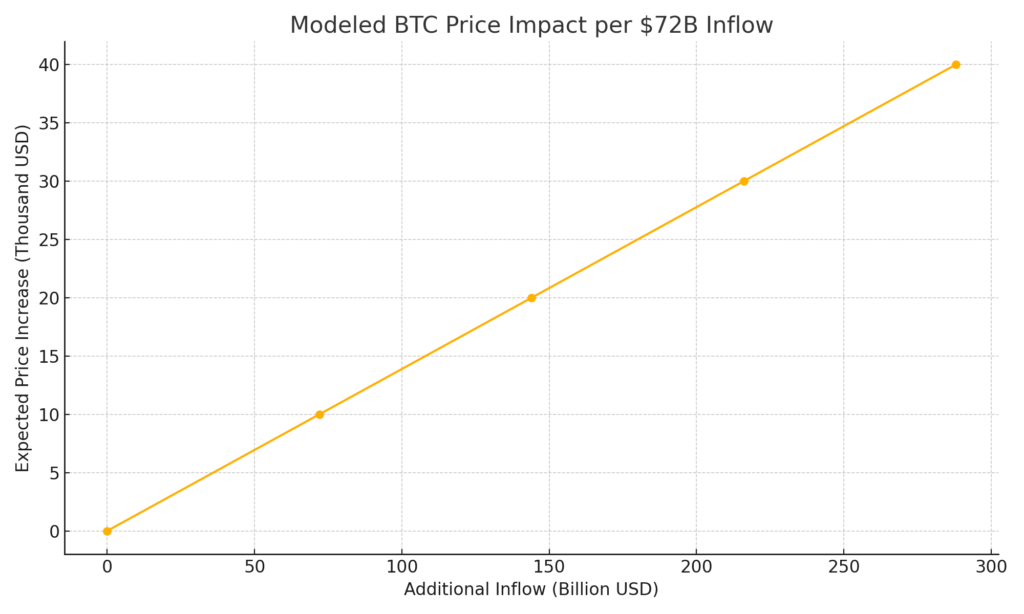
Main Points :
- 10x Research pegs a $141,861 BTC year-end target, but warns of a summer correction as options markets overheat and liquidity thins.
- Achieving that target implies roughly $281B in additional inflows—about $10K price impact per each $72B of new capital.
- Largest exchange net inflow since July 2024 signals profit-taking by institutions and capital rotation that could fuel altcoin outperformance.
- Coinbase (COIN) trades ~22% rich versus BTC; 10x shifts to “neutral-to-short” on COIN while staying constructive on BTC.
- Macro & policy calendar turns quiet after the July 29–30 FOMC, as Congress enters recess post “Crypto Week.” Seasonal data show August–September are historically weak for BTC.
- U.S. regulation leaps forward: The House passed three crypto bills and President Trump signed the GENIUS Act, creating a federal stablecoin framework—an evolving backdrop investors must price in.
- Tactics for builders and investors: Hedge overheated calls, accumulate fundamentally strong alts, and position products for stablecoin rails and compliant tokenization.
“Bitcoin Capital Inflows (2025)”

“Modeled BTC Price Impact per $72B Inflow”

1. The 10x Research Call: Huge Upside, But Mind the Heat
Crypto research firm 10x Research released a July 22 report projecting $141,861 for BTC by December 2025—a level that would require an additional $281B in capital on top of the roughly $195B year-to-date inflows. Their model implies roughly $10,000 of BTC price appreciation per $72B of incremental inflow. These numbers underscore why so many traders see spot ETF demand and institutional entry as the key driver of the “second leg” higher. However, 10x simultaneously waves a caution flag: the options market is lopsided toward calls, signaling crowded positioning that often precedes shakeouts. (Data from the user-supplied article.)
In options land, 10x notes heavy open interest around $140K (September expiry) and $150K–$200K (December expiry)—evidence of frothy sentiment. When put demand collapses relative to calls, as it has now, markets become vulnerable to gamma-driven selloffs if spot stalls. (User article.)
2. Exchange Inflows Spike: Profit-Taking or a Prelude to Alt Season?
On July 22, CryptoQuant analyst ShayanMarkets highlighted that BTC just saw its largest net inflow to exchanges since July 2024—typically a sign that big holders are preparing to distribute or hedge. That raises near-term downside risk for BTC, but also hints at capital rotation into altcoins, as profits migrate down the risk curve.
Historically, large exchange inflows precede elevated volatility and deeper pullbacks. Yet they also precede sharp, liquidity-driven altcoin rallies when sidelined capital looks for higher beta. Builders should be ready with token launches and liquidity programs; traders should watch for sector-specific rotations (L2s, RWA tokens, DePIN, AI/ML coins) that benefit from renewed speculative flows.
3. Coinbase vs. Bitcoin: The Valuation Gap Widens
10x’s report didn’t stop at BTC. It argued Coinbase (COIN) is ~22% overpriced versus Bitcoin, trading near the top of its historical relative range. With a price/earnings ratio around 145x, 10x flipped from “neutral” to a “short COIN / long BTC” stance—a classic relative-value hedge when an exchange stock rallies faster than underlying volumes or fee capture.
For investors, this relative trade makes sense if BTC chops sideways or corrects: COIN’s multiple could compress, while BTC may hold up better thanks to structural flows (ETF allocations, corporate treasuries). For builders, rich exchange multiples imply investor demand for fee-take platforms—yet also remind us that equity investors can overshoot fundamentals in hype cycles.
4. Macro & Policy Calendar: After FOMC, a News Hole
The U.S. Federal Open Market Committee (FOMC) meets July 29–30, and then Washington largely goes quiet as Congress heads into summer recess—which 10x cites as a reason for thinner liquidity and fewer catalysts.
Just before that lull, Capitol Hill staged a “Crypto Week”: the House passed three bipartisan crypto bills—including the GENIUS Act (stablecoin regulation), the Anti-CBDC Surveillance State Act, and the Digital Asset Market Clarity Act clarifying SEC/CFTC roles. President Trump signed the GENIUS Act into law on July 18, marking the first comprehensive U.S. federal stablecoin framework. The Senate Banking Committee is also advancing its own market-structure draft.
Implication: Regulatory clarity tends to unlock institutional pilots—think tokenized T-bills, compliant yield-bearing stablecoins, and permissioned DeFi. But with lawmakers gone in August, don’t expect fresh legislative catalysts until autumn.
5. The Seasonal Trap: August–September Weakness
Seasonality studies (Seasonax, CoinDesk) show BTC habitually underperforms from late May through late September. Combine that with options crowding and exchange inflows, and a summer drawdown looks more probable than not. That’s not a call to abandon longs—just to adjust position sizing, hedge with puts or spreads, and stagger spot buys to exploit volatility.
6. Strategy Playbook for Investors & Builders
A. Hedge the Overcrowding
- Roll some deep OTM calls into put spreads or collars to protect against a 15–25% air pocket.
- Use calendar spreads: sell rich near-term IV and buy longer-dated optionality into Q4 if you believe in the 10x target.
B. Rotate Into “Fundamental Alts”
- Track on-chain cash flow tokens (RWA, DePIN) and L2 infrastructure poised to benefit from capital rotation.
- Favor projects with real revenue or protocol fees—these attract sticky capital when macro noise rises.
C. Build on Stablecoin Rails
- The GENIUS Act’s clarity will accelerate USD-backed stablecoin use cases (payroll, B2B settlements). Builders should integrate compliant issuers (likely large banks or licensed fintechs) and prepare for KYC’d wallets and AML obligations.
D. Prepare for Autumn Liquidity
- If August/September soften prices, accumulate your target assets steadily.
- Launch marketing pushes and product updates into Q4, when flows tend to return and options gamma can flip bullish again.
7. Practical Signals to Watch
- ETF net flows & custodial wallet growth: Validate whether the $72B → $10K heuristic still holds.
- Deribit OI skews & delta positioning: A sharp resurgence in put buying can mark a local bottom.
- Exchange netflow trend: Sustained outflows after a spike often mean accumulation is back on.
- COIN/BTC ratio: If COIN underperforms sharply without BTC weakness, profit-taking may have begun in equities first.
Conclusion
The road to $141,861 BTC is plausible but paved with summer potholes: crowded call positions, thinning liquidity after the July FOMC, and a historical August–September lull. Yet structural drivers—regulatory clarity (GENIUS Act), institutional spot demand, and stablecoin adoption—remain intact. Expect a shake-and-bake phase: profit-taking pushes BTC into a choppy range, capital migrates to select altcoins, and volatility offers entry points for disciplined investors.
For builders, this is the window to ship products that leverage compliant stablecoin rails and tokenized real-world assets, while for traders, hedged long-BTC / selective-alt strategies and relative-value plays (short COIN vs. long BTC) can capture both sides of the tape. Survive the summer, and you may arrive in Q4 with dry powder just as the next leg begins.

